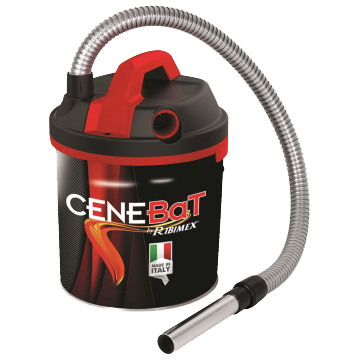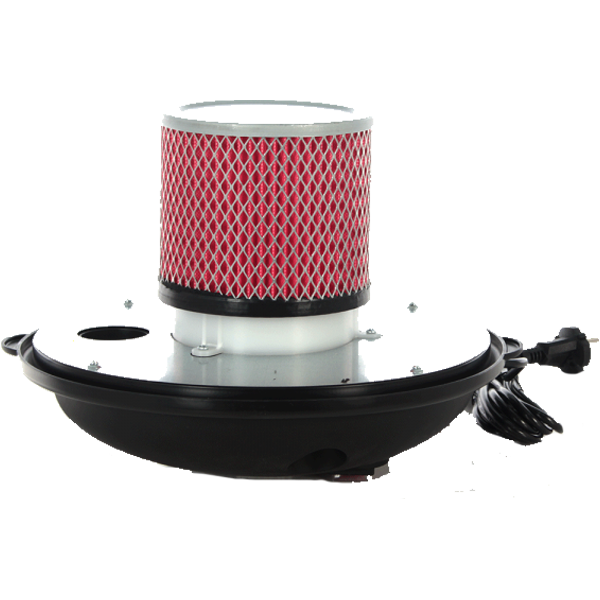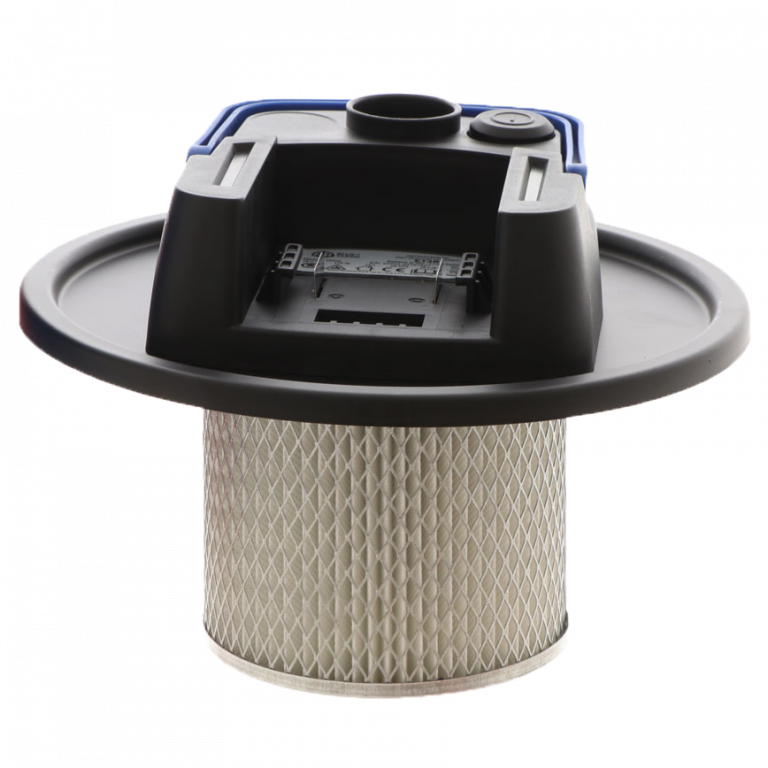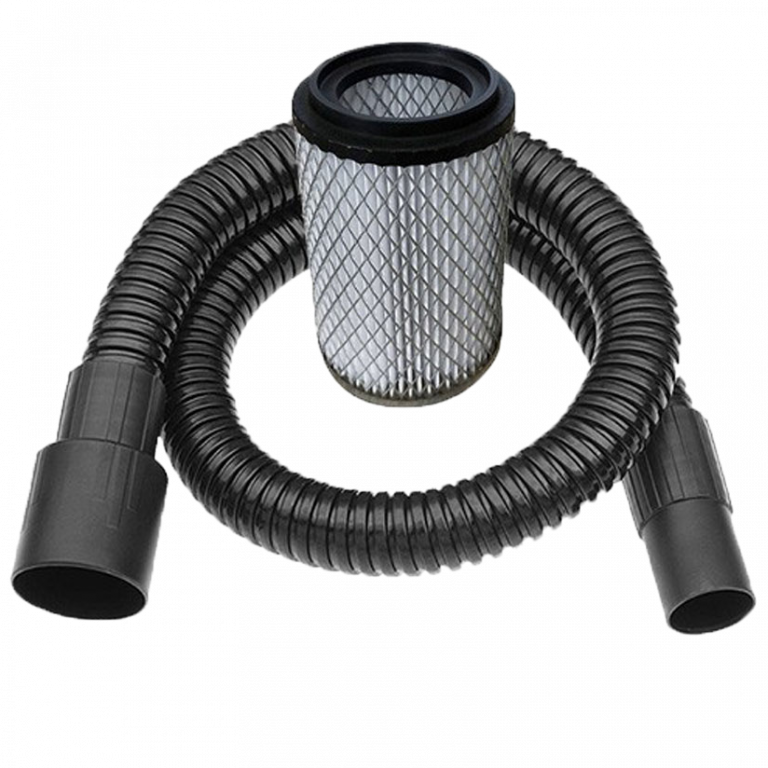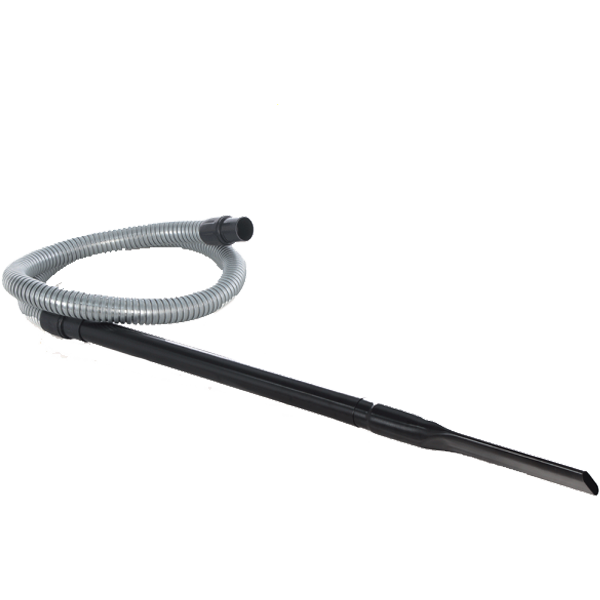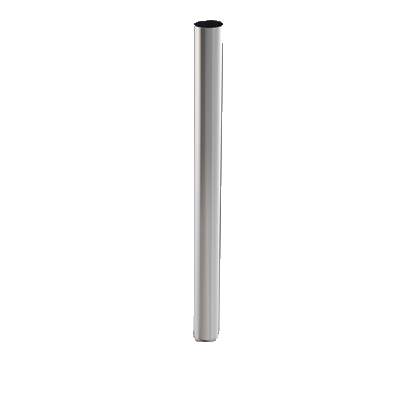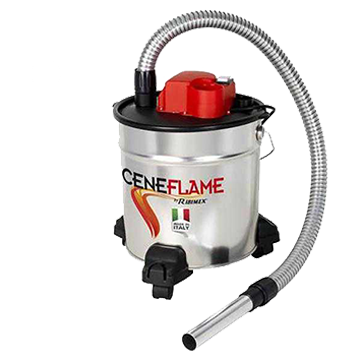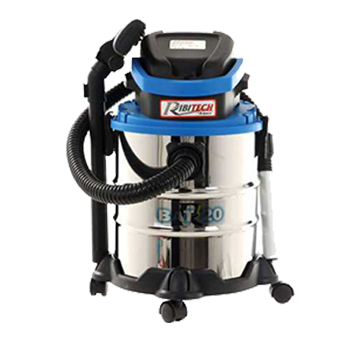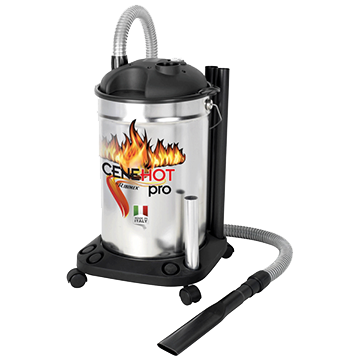A comprehensive guide to purchasing ash vacuum cleaners, clearly and comprehensively explaining how to choose the best one for your needs.
The Complete Guide to help you choose the Best Ash Vacuum Cleaner
by the Real Experts of Cleaning Machinery
Among the various types of vacuums, ash vacuum cleaners are a type of wet and dry vacuum cleaners specifically designed for removing ashes from fireplaces, stoves, pellet stoves, barbecues and wood-fired ovens. They are excellent allies in domestic cleaning and more. Thanks to special types of filters and the use of fireproof materials, these machines are able to easily and quickly remove ash and combustion waste.
This clear and complete purchasing guide will help you choose the best ash vacuum cleaner according to your needs.
CONTENTS
1. Why choose an ash vacuum cleaner instead of an ordinary vacuum cleaner?
Before starting, it is necessary to make a clear distinction between two machines that are often confused, despite having different functions: ash vacuum cleaners and vacuum cleaners.
The most common mistake is to use wet and dry vacuum cleaners or ordinary vacuum cleaners to clean fireplaces or stoves.
This bad practice not only makes the work more time-consuming and complex, but also risks damaging the vacuum cleaner and impairing its efficiency.
The simple reason is that there is a big difference between dust and ash.
Ash is a special type of dust, thinner and, at the same time, heavier, whose particles are too small to be blocked by the filter of a normal vacuum cleaner. The greatest risk is precisely the clogging and the subsequent breakage of the tool.
On the other hand, any ash vacuum cleaner is specially designed to capture ash and combustion debris through special filters for easy disposal.
Another very important aspect concerns the construction materials and the heat resistance. An ash vacuum cleaner must be strictly fireproof and have good resistance to high temperatures.
In fact, other types of vacuums not made from specific materials may experience serious damage to some key components, in particular the filter.

The metal tank of these ash vacuums not only withstands high temperatures, but is also resistant to impact and wear over time, ensuring that these appliances last longer and do not run the risk of accidental breakage.
Another very important aspect to consider is the user-friendliness of an ash vacuum cleaner, which is far superior to its counterpart.
With an average weight of less than 5 kg, these small ash vacuums are very lightweight and easy to move around and lift, thanks also to the handle and the wheels, depending on the type of model chosen.
The nozzle and lance allow you to reach the narrowest and most hidden spaces in the fireplace easily and without too much effort.
Finally, ash vacuum cleaners are a cost-effective solution for everyone, with prices starting at around €20 for basic, but no less functional versions.
2. What does the structure of an ash vacuum cleaner look like?
An ash vacuum cleaner, in its most essential form, can be divided in 4 basic sections:
- The tank (fig. 7)
- The engine and the filter (fig. 4, 5 and 6)
- The tube (fig. 9)
- The lance (fig. 9)

2.1 The tank
The tank is a key component of the ash vacuum cleaner and represents the starting point on which the choice of the entire machine should be based.
It is the container in which the collected dirt is deposited, and it is therefore necessary to pay particular attention to its capacity, extension, size, construction materials and accessories, to be able to choose the model that best suits your needs.
The classic tank is made of fireproof material, with a cylindrical shape of various sizes and an optimised design to give the tool greater stability.
As it is developed in height, it is important that the weight and size of the ash vacuums are able to keep the whole structure stable.
The handle is mounted on the vast majority of models. Often placed at the top of the tank, it allows the ash vacuum to be transported during use and proves to be very practical for the discharge of ashes.

Another important aspect when choosing an ash vacuum cleaner is the type of opening, which allows the cleaning of the filter and dust container inside the tank.
In standard versions, the motor also acts as a lid and is secured by steel hooks on the sides of the tank.
Once the lid is removed, simply turn the tank upside down to empty and clean it, just like a normal bucket.
In more elaborate and professional models, emptying is facilitated by special types of opening, specific to each ash vacuum cleaners. In the case of larger models, we can find practical levers to flip the collector over and make emptying operations much easier.
The tank can also be equipped with wheels and castors, in some cases removable, and with bases that also function as tool holders, either for the stability of the ash vacuum or for greater practicality.
2.2 The electric motor and the filter
The (electric) motor is the active part of an ash vacuum cleaner. It is a key component that enables the machine to function and therefore to efficiently perform vacuuming.
It is located in the upper part of the tank and is directly connected to the filter, which has the function of capturing and trapping dirt inside the tank.
At this point, due consideration must be given to the power of the motor, in particular concerning vacuum depression and flow rate. These two factors are crucial in assessing the performance and efficiency of the machine.
Vacuum depression is indicated by the unit kpa (kilopascal) or mbar (microbar) and it corresponds to the suction force, i.e. the ability to create a sufficient vacuum to lift the ash and deposit it inside the tank or bag.
Instead, the flow rate is measured in l/s (litres per second) and refers to the amount of air that the ash vacuum cleaner is able to draw in.
The ratio between these two factors will give the value of the machine’s power.
Electric or battery-powered motor: which one to choose?
In addition to the traditional and more common electric ash vacuum cleaners, there is a type recommended for those who need an user-friendly and efficient tool, suitable for cleaning operations even when there is no electrical power.
We’re talking about battery-powered (or portable) ash vacuums, a special category that, thanks to the rechargeable battery provided, is able to guarantee a good working autonomy.
This type of ash vacuum cleaners is ideal for all beginners who are not very familiar with the tool and therefore are more likely to move towards a lightweight, practical and user-friendly type of machine.

Annovi Reverberi AR12
Battery-powered Ash Vacuum Cleaner
Lavor Free Vac 1.0
Battery-powered Ash Vacuum Cleaner
Ribimex Cenebat
Battery-powered Ash Vacuum Cleaner
While the engine is only realistically comparable in terms of power, the filter mainly falls into 3 distinct categories. This is another key feature to take into account when choosing an ash vacuum.
Cold ashes are usually defined as those with a temperature below 40°C.
This is the most common type of filter. It is often made of non-metallic material and has a mesh that captures the ash without releasing it into the environment.
In many cases, the filter is washable and can be used countless times before being replaced.
Although it is one of the most affordable models on the market, it is still very powerful and efficient, as long as the recommended temperatures are respected, as indicated in the user guide.
When we talk about “hot ash“, we mean ashes with a temperature between 30 and 50 degrees. On the other hand, if the temperature exceeds 50 degrees, it is called “burning” ash.
The filter for hot ashes is particularly suitable for cleaning fireplaces quickly, without having to wait for the ashes to cool down. In general, they are manufactured with a metal housing and fireproof mesh which is capable of trapping ashes above 30 degrees without causing any damage.
Even if mounted on a high temperature resistant tank, it is nevertheless not recommended to use the ash vacuum cleaner with still burning ashes. Generally, it is advisable to always wait until the ashes are extinguished.
Water filters
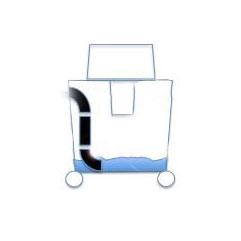
This is the least common type of filter, but no less useful.
It uses water as a filtering medium, which traps the ash and then separates it from the suction nozzle.
As can be seen from the picture, the dirt that is vacuumed up has to necessarily pass on a water level. In this way, the action of water blocks ashes and dust.
This type of filter considerably reduces the dispersion of ash and dust into the air.
Besides being recommended for all those suffering from dust allergies, this ash filter system is undoubtedly the most functional and easy to maintain.
Filter shaker
In order to get the most out of ash vacuums and avoid clogging that could compromise efficiency and performance, it is essential to carry out regular filter maintenance.
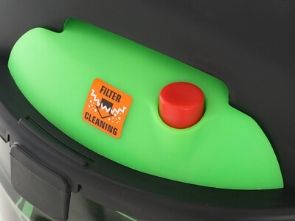
To facilitate this procedure, some ash vacuum cleaners are equipped with a practical accessory, which is called filter shaker. This can be pneumatic or automatic.
The pneumatic system is operated by means of a simple button, usually located at the top of the ash vacuum, which generates a reverse air blow that acts on the various ash residuals deposited on the filter.
In order to avoid continuous cleaning and maintenance of ash vacuum cleaners, self-cleaning models have also been designed. These particular types of ash vacuum cleaners are equipped with state-of-the-art technology that cleans both the filters and the internal components of the ash vacuum cleaner.
Automatic filter shakers, on the contrary, have the ability to operate on their own, without the user having to start it manually each time.
This innovative self-cleaning system ensures proper maintenance of the ash vacuum and the filters.
2.3 The tube
The choice of tube is linked to the single ash vacuum cleaner or the brand type, as it must be equipped with its own proper coupling to hook/unhook the tube to the ash vacuum.
Premium-range ash vacuums feature the possibility to add different hoses than the one supplied to the purchase, thus customising the cleaning experience according to the user needs.
Made from a variety of materials, from plastic to metal alloys, the tube is usually coiled to allow movement and flexibility while maintaining great resistance and strength.
A metal tube is preferable to PVC because of its durability and high temperature resistance.
Another noteworthy aspect is the tube length. A longer tube may mistakenly seem more comfortable and functional, but this is not always the case: excessive length has the disadvantage of a considerable loss of power, penalising the performance of the machine.
It is therefore advisable to find a compromise between the length strictly necessary and the power that is really needed.

Filter and tube 
Tube and lance 
Metal lance
2.4 The lance
The lance is the part that is held by the user during cleaning operations.
When choosing a lance, in a similar way to the ash vacuum tube, it is important to consider its length and construction materials, but, above all, its shape and ergonomics.
As mentioned above, for the choice of materials and length you can refer to the section about the tube (2.3).
It is advisable to move towards lances made of metal (as they are stronger than plastic), preferably not too long so as not to lose vacuum power.
More important, however, are the shape and ergonomics of the lance. For the first aspect, it should be considered that a narrow, angled tip can easily reach corners, whereas a wider tip has a greater range of action. Finally, ergonomics is a purely personal aspect, which varies from one person to another.
On the other hand, it is an objective fact that an ergonomic lance significantly reduces fatigue during machine use, especially when used over a long period.
It is important to note that these are precisely accessories attached to the ash vacuum and not industrial quality products that are usually purchased separately. Before looking for the version with the most functionality, you should always consider the end use to be made of the tool.
If the quality of the product is not suitable for the type of work to be carried out, the ash vacuum cleaner will be prone to continuous breakdowns (especially in the filter) and, in the worst case, breakage of the filter. Consequently, before leading the malfunctioning or the poor functionality back to the filter or the machine itself, it should be verified that the tool is actually suitable for its intended use.
An ash vacuum for professional work, such as cleaning operations of wood-fired ovens in restaurants, should preferably be made of metal, with a durable, fireproof structure and, if speed is required, able to vacuum up hot ash. Conversely, for occasional vacuuming of the ash from a pellet stove, a small tank and a plastic tube will be sufficient.
No accessory will be able to avoid damage to the machine if the structure is made of materials unsuitable for the amount of work to be done.
Finally, if a dust collection tool feels like it takes up too much space or it is considered an unnecessary purchase, there is a hybrid category of vacuum cleaners/ash vacuums, which includes larger ash vacuum cleaners with similar characteristics to average vacuums capable of efficiently removing household dust.
This type of ash vacuum cleaner, in addition to its normal functions, is able to deliver the same performance of an average vacuum; on the contrary, there is no vacuum cleaner truly capable of acting as an ash collector, again for the reasons mentioned above.

3. The performance
Once the right type of model has been identified, the actual performance of each ash vacuum cleaner can be assessed.
It is only on the basis of the ratio of the vacuum depression to the flow rate that the actual power of each ash vacuum cleaner can be identified.
Vacuum depression is the capacity of the ash vacuum cleaner to lift and vacuum up heavy material, and is measured in millibars (mbar) or kilopascals (kpa).
A top-quality ash vacuum cleaner has on average a vacuum depression of more than 200 mbar (20kpa), while cost-effective models have around 120 mbar of vacuum depression.

Ribimex Ceneflame
1200 Watt – 18 L Sheet metal tank
Ribimex RBAT20 – 4 in 1
20V – Stainless steel housing
Ribimex Cenehot
1200 Watt – Automatic filter shaker
The flow rate is the amount of air, usually expressed in litres per second, that an ash vacuum cleaner is able to draw in.
In this case, the quality of the ash vacuum cleaner has a greater influence on the purchase, as a cost-effective model draws in an average of 30 litres/second, while a more advanced model can vacuum in more than twice this amount, even exceeding 60 litres/second.
Finally, it is worth mentioning the power consumption, i.e. the amount of current drawn by an ash vacuum cleaner.
The power consumption of an ash vacuum normally ranges between 500 and 1500 W (it may increase in hybrid models of vacuums/ash vacuum cleaners).
It goes without saying that, for the same performance, the one with the lower consumption will also impact on the consequently energy savings.
In summary, it is advisable to move towards a domestic ash vacuum cleaner with a vacuum depression of around 150 mbar, a flow rate of more than 30 litres/second and a power consumption of 800-900 watts.
4. Top brands
Before proceeding with the purchase of an ash vacuum cleaner, another aspect should be taken into consideration: the brand.
As with other types of products, choosing a well-known and trusted brand, such as Lavor, Karcher, Vigor, Ribimex, Yamato, Vinco and Einhell, means to be able to count on quality, reliability and safety.






